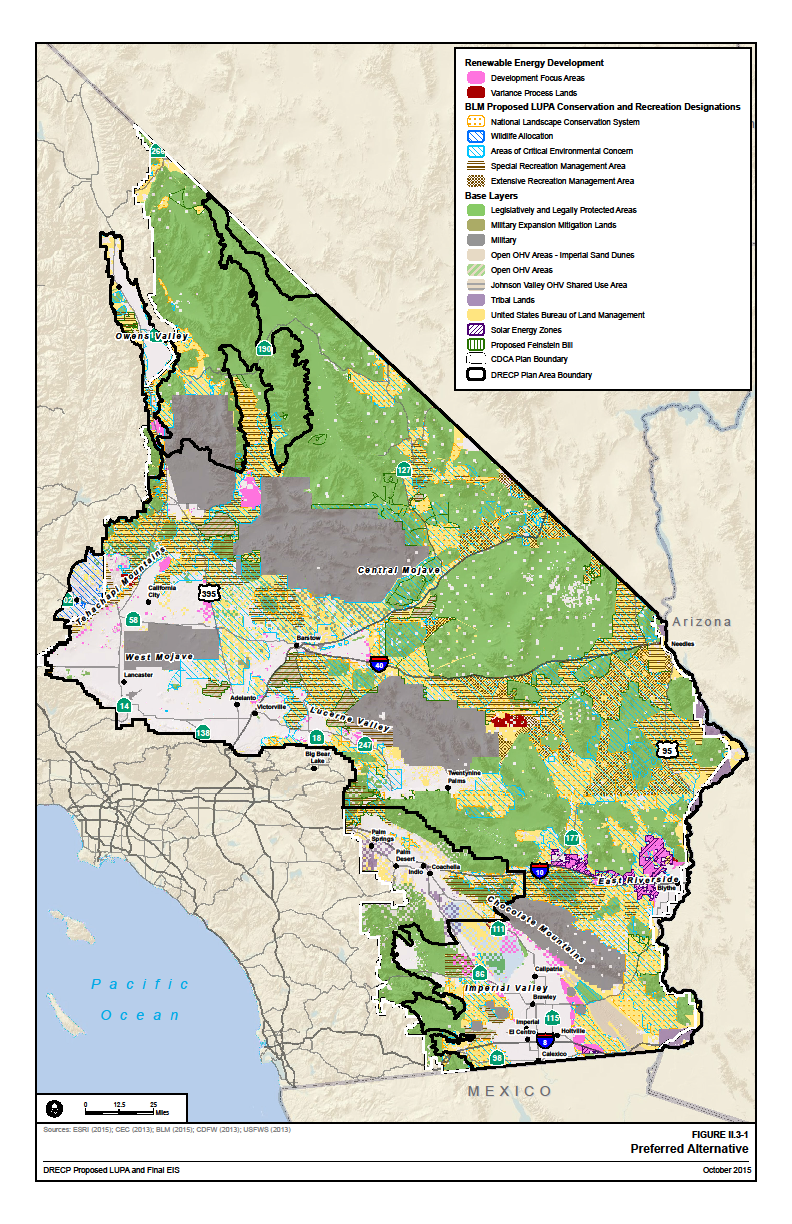Desert Renewable Energy Conservation Plan
According to the Bureau of Land Management’s website, the purpose of the Desert Renewable Energy Conservation Program (DRECP) is “to conserve and manage plant and wildlife communities in the desert regions of California while facilitating the timely permitting of compatible renewable energy projects.”
The idea is this: state and federal legislation over the past decade have fast-tracked renewable energy projects. While this was good for the growth of renewable sector and the battle against climate change, it is important to consider the other ecological impacts of renewable energy development. DRECP aims to consider the development of renewable energy in tandem with conservation goals.
Audubon California hopes and expects that DRECP will be finalized by September 2016.
How DRECP Works
Because California has such a huge expanse of desert land—22 million acres—the Plan has been divided into two parts in order to address both public and private lands in the area.
Phase I: Allocating Public Lands
The first phase of DRECP includes an environmental assessment and Land Use Plan Amendment (LUPA) for 12.5 million acres of public lands traditionally run by the Bureau of Land Management. The proposed LUPA allocates just under a half million acres for expedited renewable energy development, while adding 5.6 million acres of land for conservation—for a total of over nine million acres of protected desert habitat.
Birds in this protected land include Southwester Willow Flycatchers, Yellow-billed Cuckoos, Burrowing Owls, Red-Tailed Hawks, Golden Eagles, American Kestrels, Prairie Falcons and many more. This land is also crucial habitat for desert tortoises.
While much of this is positive news, there are still concerns with Phase I of DRECP: 800,000 acres have been left undesignated. These unallocated lands include part or all of 20 Audubon-identified important bird areas that are left unprotected.
Phase II: Allocating Private Lands
The second phase, by contrast, addresses renewable energy siting on the 10 million acres of private land in the same areas. In this phase, DRECP identified so-called Development Focus Areas.
Unfortunately, many of these areas again infringed on important habitat, but this is where Audubon California is lucky to have many dedicated chapters in Southern California. Because the DRECP interacts at multiple levels of government, the Bureau of Land Management’s suggestions are subject to county ordinances. After hard work and effective advocacy, Audubon California is pleased to report that most of the counties passed land-use ordinances that refined and decreased the overall acreage of Development Focus Areas while still identifying acres and criteria for renewable energy development.
Beyond the Phases
Often time, we think of laws as being either at the local, state or national level, but with many policies—renewable energy policy included—it is more important to look at how policies at different levels interact. This is important to remember when trying to understand the DRECP.
DRECP is a collaborative plan being administered by the Bureau of Land Management, but it particularly affects the Mojave and Colorado Deserts in California. As a reflection of the multiple levels of stakeholders, DRECP is being developed under the Federal Endangered Species Act (FESA), the Federal Land Policy and Management Act (FLPMA), the California Natural Community Conservation Planning Act (NCCPA). At the local level, DRECP has also had to work with various ordinances in Inyo, Los Angeles, Riverside, San Diego, San Bernardino and Imperial Counties.

How you can help, right now
Get Audubon CA in Your Inbox
Our newsletter is fun way to get our latest stories and important conservation updates from across the state.
Donate to Audubon
Help secure the future for birds at risk from climate change, habitat loss and other threats. Your support will power our science, education, advocacy and on-the-ground conservation efforts.
HOTSPOT: Flyover of California's Birds and Biodiversity
California is a global biodiversity hotspots, with one of the greatest concentrations of living species on Earth.



